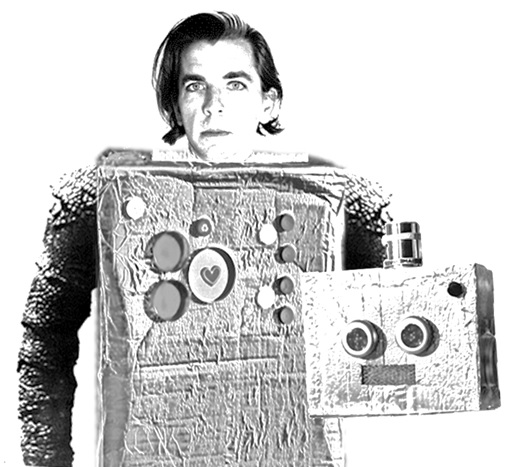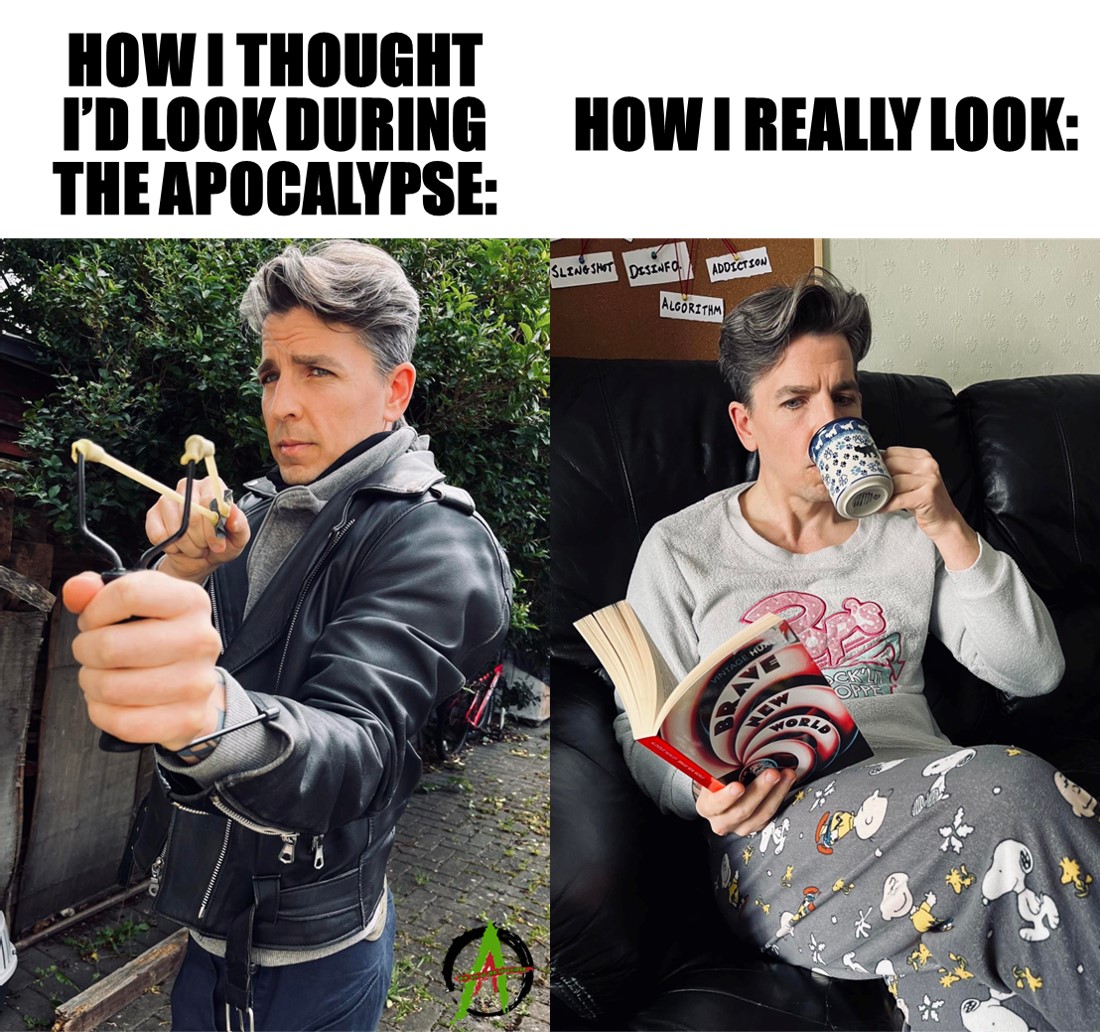The Art of the Apocalypse: Dr Scotty McQueen on A.I., Unfiction, and Ethical Interventions
 These are some of the questions Dr Scotty McQueen explores in his 21-part creative practice YouTube series, The Art of the Apocalypse: From A.I. to Zombie, which encourages viewers to redirect their relationships with narratives of the apocalypse and, indeed, digital media, in more productive and healthy directions. A behavioural insights and personal development specialist, McQueen currently holds an Early Career Research Residency with the Trinity Long Room Hub Arts and Humanities Research Institute, working on digital media in the School of Creative Arts. In an interview with Trinity’s HUMAN+ programme and the Office of the Dean of Research, Dr McQueen discusses the creative process and ethical decision-making around A.I. that is explored in The Art of the Apocalypse.
These are some of the questions Dr Scotty McQueen explores in his 21-part creative practice YouTube series, The Art of the Apocalypse: From A.I. to Zombie, which encourages viewers to redirect their relationships with narratives of the apocalypse and, indeed, digital media, in more productive and healthy directions. A behavioural insights and personal development specialist, McQueen currently holds an Early Career Research Residency with the Trinity Long Room Hub Arts and Humanities Research Institute, working on digital media in the School of Creative Arts. In an interview with Trinity’s HUMAN+ programme and the Office of the Dean of Research, Dr McQueen discusses the creative process and ethical decision-making around A.I. that is explored in The Art of the Apocalypse.
McQueen quasi-roleplays as an apocalypse survivalist: the self-proclaimed “Crazy Conspiracy Dude,” who guides viewers through apocalypse-themed workshops for survival-based activities, including disaster preparedness, self-defence, wilderness survival, and sustainable digital practices. The YouTube series includes a section on the A.I. apocalypse, which Crazy Conspiracy Dude describes as “a three-part series, designed around the trinity of human badassness: the mind, the body and the spirit.” He goes on to explain that “for the moment, it is still possible to take advantage of digital technologies without letting digital technologies take advantage of you.”
These videos explore concepts from the fields of philosophy, psychology and physics among others, incorporating thought experiments, magic tricks, and reflections from writers and thinkers throughout history. This enables McQueen’s avatar to demonstrate strategies of awareness regarding the influence digital technology has on our lives. After all, he points out, if tasked with creating an A.I. that could manipulate humans into destroying their own civilization, “you might have a hard time coming up with a more efficient solution than the engagement-maximizing algorithms already controlling your own social media feeds.”
Crazy Conspiracy Dude, then, encourages the viewer to reflect on their own relationship with digital technologies. This includes being cognisant of our own thought patterns, our embodiment – how physical actions can stop or redirect disruptive thought patterns – and awareness of the here-and-now. Throughout his series, McQueen is not only critiquing apocalyptic narratives, but deconstructing and reconstructing them in order to guide ethical and data-supported educational content.
This project enabled him to look at how lines around apocalyptic narratives, including the zombie, the viral, the robot, and the algorithmic, are blurring into everyday life. Indeed, The Art of the Apocalypse connects to McQueen’s first PhD in Performance Studies from UCC in relation to alternate reality cultures: how people incorporate “unfictions,” narratives which blur the boundaries between fiction and reality, into their lives. “There’s an anti-zombie militia in Kansas stockpiling weapons,” he gives as an example. “Are they pretending? I can’t necessarily label an idea as fiction, when there are people taking it very seriously. I have to engage with these works not just as they are objectively, but how they are engaged with subjectively.”
McQueen, then, reimagines how we connect to unfictions that can be destructive in nature, by rewriting them in a form that can instead empower individuals to make more positive choices. “In the same sense that Jacques Derrida discussed deconstruction, I’m trying to deconstruct these stories and then reconstruct them as interventions rather than simply retell them in a different context.”
McQueen’s concept for The Art of the Apocalypse began with the use of the zombie figure as a tool for creatively resolving some of the problematic aspects of contemporary self-defence instruction. This intersects with his approach to A.I., too. Just as McQueen explores martial arts in the context of the zombie, as a way to empower more people to engage in real-life strategies of self-protection, he similarly empowers people to make positive decisions when it comes to digital technology. No person should have to protect themselves on the street, yet the reality is we might have to one day. The same, he argues, is true in relation to our activity online. “When it comes to defending yourself and protecting others from the hazards of digital technologies, at the end of the day, you are the last line of defence. On the whole, these new technologies are amazing, but I’m sure I don’t need to explain the risks and trade-offs that are associated with them. Awareness of those risks may be half the battle.”
It goes all the way back to Zen, McQueen explains: “You can find all sorts of fabulous philosophy, which feels almost like it was designed for coping in digital infrastructure: you’re not really in the virtual world, you’re always here. These are ideas that are thousands of years old and are perhaps more relevant now than ever.” Indeed, The Art of the Apocalypse is filled with references from philosophers, writers and scientists, from Henry David Thoreau through to Richard Feynman and all the way to Yoda. What does this rich tapestry of cultural references bring to the discussion on digital technology? Thoreau’s Walden was, McQueen reflects, “in a sense where this whole project began.”
 Thoreau was a transcendentalist, and in his connections back to early Zen philosophy, McQueen has found a connection across time and culture to discuss the same ideas from various perspectives. “There’s something about Walden that resonates with people in the digital era. The desire to unplug and connect with nature is something that is deeply conflicting, because we simply can’t. Even in the midst of prepping for an apocalypse, I was running a YouTube channel!” Engaging with philosophers and thinkers enables us to deal with career expectations which make it almost impossible not to engage with the online world while not being consumed by it: how to find that balance.
Thoreau was a transcendentalist, and in his connections back to early Zen philosophy, McQueen has found a connection across time and culture to discuss the same ideas from various perspectives. “There’s something about Walden that resonates with people in the digital era. The desire to unplug and connect with nature is something that is deeply conflicting, because we simply can’t. Even in the midst of prepping for an apocalypse, I was running a YouTube channel!” Engaging with philosophers and thinkers enables us to deal with career expectations which make it almost impossible not to engage with the online world while not being consumed by it: how to find that balance.
McQueen’s research is in many ways a parallel discussion to those surrounding A.I. policy and governance, which are currently taking place in Trinity’s HUMAN+ programme: he describes his research as a “grass roots strategy.” While policy issues are worked from the top down, his approach spreads its messages via popular media so that they resonate with wider audiences. Moreover, he points out, this is an approach that could only be arrived at through the use of creative practice methodologies. The Art of the Apocalypse looks at the individual user. “It asks them, while others deal with policy issues, what are you doing today to help technology improve your life without detrimental consequences?”
This should not simply be a parallel conversation, however. It should in fact intersect with discussion of policy. As McQueen observes, human-centred questions are exactly what conversations around policy should be addressing. His background in creative practice brings a unique viewpoint in relation to digital media. His doctoral research thus far has all been conducted via the approach of creative practice, which has given him the opportunity to experiment, reflect and refine this cycle: “I was influenced a lot by Dwight Conquergood, who suggested that creative practice should be triangulated around the pivot points of artistry, analysis, and activism – or creativity, critical reflection, and civic engagement. This approach makes it possible to conduct embodied research in ways that are both methodical and meaningful.”
The Art of the Apocalypse, then, is ultimately about “protecting yourself, your family, friends, neighbours and pets in a zombie apocalypse, during the rise of the machines, or just in everyday life.” According to McQueen, “We don’t need to unplug from digital media completely. We just need to plug into the here-and-now and be aware of our cognitive weak spots, so we can avoid the rabbit hole of worry, fear and paranoia.” Surprisingly, the imaginary “apocalypse” can be a useful tool for accomplishing this. As McQueen puts it on one of his “self-defence for the A.I. apocalypse” videos: “The apocalypse is not a destination, it’s a journey.”
You can watch the individual Art of the Apocalypse videos here:
- Article written by Dr Sarah Cullen
Scotty McQueen
Dr. Scotty McQueen is conducting doctoral research on digital media, conspiracism, and apocalypticism at Trinity College Dublin with the Film Department in the School of Creative Arts. He holds a PhD in Performance Studies from University College Cork, an MPA in Strategic Public Policy from the American University of Paris, and an MFA in Physical Theatre from the Accademia dell’Arte in Tuscany. Dr. McQueen is a member of the Global League of Magicians & Mentalists, a practitioner of Shotokan Karate, and an ordained minister of the Church of the Flying Spaghetti Monster. He is the author of The End of Mind Reading; Luck, Love & Psychic; and Performing Psychic: The Performance of Mentalism and Psychic Arts on Stage, Screen, and in Everyday Life.

